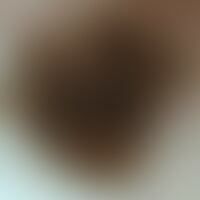Keratosis seborrhoeic (overview) Images
Go to article Keratosis seborrhoeic (overview)
Verruca seborrhoica: General view: On the left side of the picture a 10 x 7 mm large, brown-black, broadly basal knot with a verrucous, fissured surface on the forehead of an 81-year-old female patient.

Verruca seborrhoica. soft, raised, grey-brown to black papules and plaques with a fissured, warty surface, interspersed with black horn stoppers. variable size, from a few mm to about 1.2 cm in diameter. disseminated appearance.

Keratosis seborrhoeic: flat, gradually growing dissected brown plaque with a slightly punched surface, known for years. no discomfort. no bleeding

Verruca seborrhoica. chronically stationary, solitary, brown to brown-black, exophytic node with wart-like surface, which has not been growing for years. in places a brown horn material can be easily detached from the surface.


Verruca seborrhoica: multiple Verrucae seborrhoicae. continuous development since the 4th decade of life.

verruca seborrhoica: multiple verrucae seborrhoicae. continuous development since the 4th decade of life. findings: densely standing, 0.2-1.0 cm large, yellowish also brownish flat papules. individual seborrhoeic keratoses itch repeatedly. no clinically detectable inflammatory symptoms.

keratosis seborrhoeic: multiple flat wart-like skin growths that have persisted for years. arrows mark smaller, flat, light brown seborrhoeic keratoses. encircled: verucosal plaques or nodules that have existed for a long time (several years). patient complains of itching at times.

verruca seborrhoica. multiple verrucae seborrhoicae, here as a familial disease. densely standing, mostly pinhead-sized, brownish flat papules aggregated in places. occasionally itching. clinically morphologically no inflammatory symptoms detectable (see below dermatosis papulosa nigra).

Verruca seborrhoica: multiple Verrucae seborrhoicae. continuous development since the 4th decade of life. detailed view

verruca seborrhoica

Verruca seborrhoica: General view: For many years a 7 x 5 mm large, brown-black tumor on the left scapula of an 83-year-old female patient.

Keratoses seborrhoeic: multiple skin-colored flat wart-like papules and plaques. occasional itching.

Verruca seborrhoica: brown-black, medium-strength knot with felted surface.

Verruca seborrhoica: brown-black, broad-based, medium-strength node with a fielded surface.

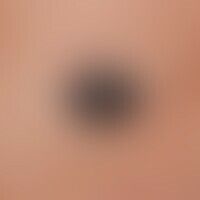


Verruca seborrhoica: brown, medium-strength knot with felted surface.

Verruca seborrhoica.


verruca seborrhoica


Keratoses seborrhoeic: Multiple different sized,seborrhoeic tumors with a porous surface.

Keratosis seborrhoeic: multiple, flat, light brown raised areas with a verrucous surface.

Keratosis seborrhoeic: Detailed picture of a new formation existing for about 1 year; occasional itching.

Keratosis seborrhoeic: colourful mixture of younger and olderseborrhoeic keratoses.

Verruca seborrhoica. reflected light microscopy: Exophytically growing verruca seborrhoica manifested in the upper thoracic region for several years in a 51-year-old female patient. blurred, deep brown tumor. numerous pseudohorn cysts, shown as differently sized, round, light brown spots. upper right: telangiectasia. in the surrounding area irregular pigment network with telangiectasia as an expression of a pronounced solar exposure.
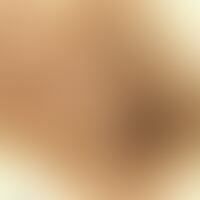

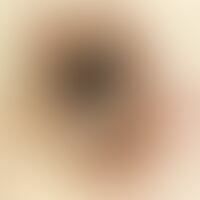
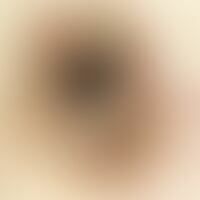

Verruca seborrhoica. acanthotic type. broad-based, exophytic tumor, no infiltrating growth; appears as "put on". numerous, almost ideally round pseudohorn cysts. low surface keratinization. at the base, an inflammatory infiltrate of varying density is visible.






